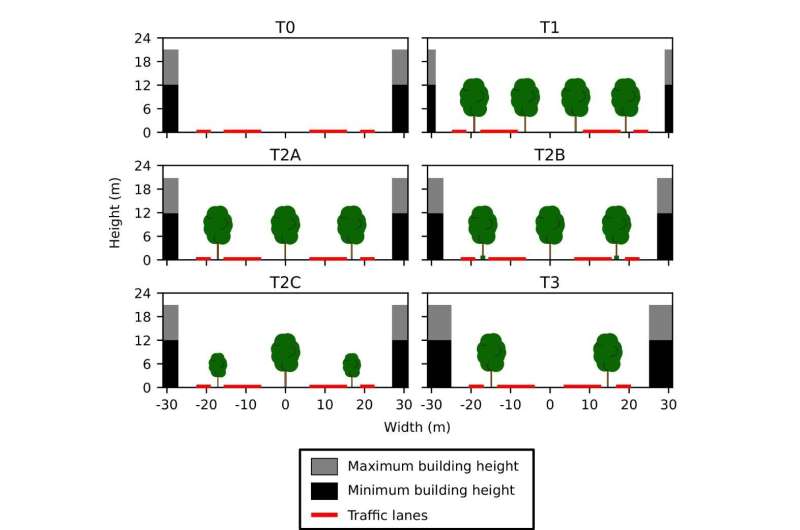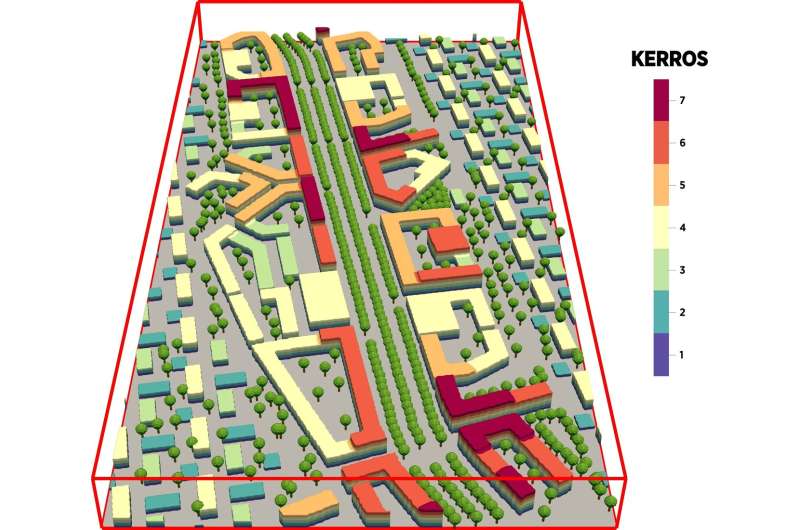Variance in tree species results in the cleanest urban air

A study carried out at the Institute for Atmospheric and Earth System Research (INAR) of the University of Helsinki modeled how different street-tree alternatives and the location of the trees affect air quality on the pedestrian level. The study was carried out in collaboration by the University of Helsinki, the City of Helsinki and the Finnish Meteorological Institute.
In the end, the best option was found to be a row of taller common lime trees (Tilia x vulgaris) in the middle of the street canyon and lower Swedish whitebeams (Sorbus intermedia) lining the sides.
"In that case, the air was one-fifth cleaner compared to the least favorable option, that is the one with four rows of trees of equal height," says Associate Professor Leena Järvi, head of the research group.
Järvi considers the difference surprisingly marked. Another find that can be considered a surprise is the fact that meter-high hedgerows located under the tree row closest to the edge were seen to have no practical impact on the air quality of pavements.
Trees prevent pollutant ventilation
Globally, air pollution kills approximately seven million people every year. Even in relatively clean country such as Finland, hundreds of people die (1560 in 2016) as the result of air pollution every year, which makes the reduction of small particle concentration important.
The City of Helsinki is currently designing new city boulevards to replace a few of the entry motorways in order to answer the densification needs of the city. These boulevards will be accommodated and accessed by several people at the same time with expected high traffic rates. As one mean to improve the local air quality, the city is interested on vegetation, which has multiple positive effects to our well-being and aesthetics.

The cleanest air in street canyons would be achieved without any trees at all, as street trees reduce wind speed and, thus, impair the airing out of traffic pollutants from the street canyon. At the same time, vegetation is needed, for example, for ensuring wellbeing, which makes a treeless option unrealistic for planning.
In the options investigated, the number of tree rows ranged between two and four, with the latter option being four meters wider and the one with two rows of trees four meters narrower than the three-row option, as stipulated by the rules of urban planning. In the option with three rows of trees, the effect of hedgerows located beneath the trees and that of various tree species was investigated as well.
Particle size also matters
The attachment of particles to vegetation does reduce the particle concentration in the air, but the effect is slimmer than the increase brought about the deceleration of wind, or the reduced ventilation of the street canyon. The smallest aerosol particles were more apt to bind with vegetation compared to the larger ones, which is why increasing the number of trees increased the number of the smallest particles found in the air less than that of larger particles.
With trees of uniform height in three rows, the concentration of small particles under 10 micrometers in size grew by 88%, with even the concentration of particles under 2.5 micrometers increasing 42% compared to the entirely treeless street canyon. The option with three rows of trees with different heights, which was the cleanest option, increased the concentration of small particles under 10 micrometers by 75% and that of small particles under 2.5 micrometers by 35%.
The study applied the high-quality PALM model designed for air quality modeling, which enables the assessment of air quality differences with a very fine resolution, that is, to a high degree of precision. The modeling was carried out with the CSC supercomputer, as a regular desktop computer would have spent roughly a year to compute each option, altogether some 12 years taking all wind direction and tree options into consideration. For the supercomputer, this task only took approximately 14 days to complete.
More information: Sasu Karttunen et al. Large-eddy simulation of the optimal street-tree layout for pedestrian-level aerosol particle concentrations – A case study from a city-boulevard, Atmospheric Environment: X (2020). DOI: 10.1016/j.aeaoa.2020.100073
Provided by University of Helsinki





















